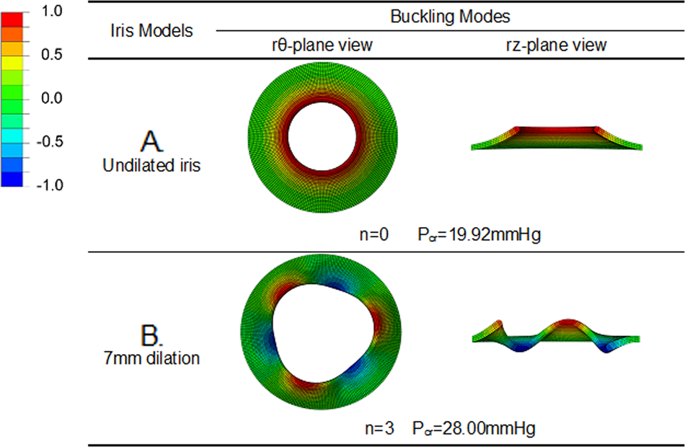Our official English website, www.x-mol.net, welcomes your
feedback! (Note: you will need to create a separate account there.)
Modelling floppy iris syndrome and the impact of pupil size and ring devices on iris displacement
Eye ( IF 2.8 ) Pub Date : 2020-02-04 , DOI: 10.1038/s41433-020-0782-7 David Lockington 1 , Zhaokun Wang 2 , Nan Qi 3 , Boris Malyugin 4 , Li Cai 5 , Chenglei Wang 2 , Hui Tang 2 , Kanna Ramaesh 1 , Xiaoyu Luo 6
Eye ( IF 2.8 ) Pub Date : 2020-02-04 , DOI: 10.1038/s41433-020-0782-7 David Lockington 1 , Zhaokun Wang 2 , Nan Qi 3 , Boris Malyugin 4 , Li Cai 5 , Chenglei Wang 2 , Hui Tang 2 , Kanna Ramaesh 1 , Xiaoyu Luo 6
Affiliation

|
Introduction The aim of this paper was to further develop a previously described finite element model which equates clinical iris billowing movements with mechanical buckling behaviour, simulating floppy iris syndrome. We wished to evaluate the impact of pupil dilation and mechanical devices on normal iris and floppy iris models. Methods Theoretical mathematical modelling and computer simulations were used to assess billowing/buckling patterns of the iris under loading pressures for the undilated and dilated normal iris, the undilated and dilated floppy iris, and additionally with a mechanical ring device. Results For the normal iris, billowing/buckling occurred at a critical pressure of 19.92 mmHg for 5 mm pupil size, which increased to 28.00 mmHg (40.56%) with a 7 mm pupil. The Malyugin ring device significantly increased critical initiating buckling pressures in the normal iris scenario, to 34.58 mmHg (73.59%) for 7 mm ring with boundary conditions I (BC I) and 34.51 mmHg (73.24%) with BC II. For the most floppy iris modelling (40% degradation), initiating buckling value was 18.04 mmHg (−9.44%), which increased to 28.39 mmHg (42.52%) with the 7 mm ring. These results were much greater than for normal undilated iris without restrictive mechanical expansion (19.92 mmHg). Conclusion This simulation demonstrates that pupil expansion devices inhibit iris billowing even in the setting of floppy iris syndrome. Our work also provides a model to further investigate the impact of pupil size or pharmacological interventions on anterior segment conditions affected by iris position.
中文翻译:

模拟虹膜松弛综合征以及瞳孔大小和环装置对虹膜位移的影响
介绍本文的目的是进一步开发先前描述的有限元模型,该模型将临床虹膜翻腾运动与机械屈曲行为等同起来,模拟松弛的虹膜综合征。我们希望评估瞳孔扩张和机械装置对正常虹膜和软盘虹膜模型的影响。方法 使用理论数学模型和计算机模拟来评估未扩张和扩张的正常虹膜、未扩张和扩张的软盘虹膜以及额外的机械环装置在加载压力下虹膜的滚滚/屈曲模式。结果对于正常虹膜,5 mm 瞳孔大小在 19.92 mmHg 的临界压力下发生翻滚/屈曲,7 mm 瞳孔增加到 28.00 mmHg (40.56%)。Malyugin 环装置显着增加了正常虹膜情况下的临界起始屈曲压力,7 mm 环与边界条件 I (BC I) 和 BC II 的 34.51 mmHg (73.24%) 和 34.51 mmHg (73.24%)。对于最松软的虹膜建模(退化 40%),初始屈曲值为 18.04 mmHg (-9.44%),使用 7 mm 环增加到 28.39 mmHg (42.52%)。这些结果远大于没有限制性机械扩张的正常未扩张虹膜 (19.92 mmHg)。结论 该模拟表明,即使在虹膜松弛综合征的情况下,瞳孔扩张装置也能抑制虹膜翻滚。我们的工作还提供了一个模型,以进一步研究瞳孔大小或药物干预对受虹膜位置影响的眼前节状况的影响。对于 7 mm 环,边界条件 I (BC I) 为 34.58 mmHg (73.59%),边界条件为 34.51 mmHg (73.24%),边界条件为 BC II。对于最松软的虹膜建模(退化 40%),初始屈曲值为 18.04 mmHg (-9.44%),使用 7 mm 环增加到 28.39 mmHg (42.52%)。这些结果远大于没有限制性机械扩张的正常未扩张虹膜 (19.92 mmHg)。结论 该模拟表明,即使在虹膜松弛综合征的情况下,瞳孔扩张装置也能抑制虹膜翻滚。我们的工作还提供了一个模型,以进一步研究瞳孔大小或药物干预对受虹膜位置影响的眼前节状况的影响。对于 7 mm 环,边界条件 I (BC I) 为 34.58 mmHg (73.59%),边界条件为 34.51 mmHg (73.24%),边界条件为 BC II。对于最松软的虹膜建模(退化 40%),初始屈曲值为 18.04 mmHg (-9.44%),使用 7 mm 环增加到 28.39 mmHg (42.52%)。这些结果远大于没有限制性机械扩张的正常未扩张虹膜 (19.92 mmHg)。结论 该模拟表明,即使在虹膜松弛综合征的情况下,瞳孔扩张装置也能抑制虹膜翻滚。我们的工作还提供了一个模型,以进一步研究瞳孔大小或药物干预对受虹膜位置影响的眼前节状况的影响。初始屈曲值为 18.04 mmHg (-9.44%),使用 7 mm 环增加到 28.39 mmHg (42.52%)。这些结果远大于没有限制性机械扩张的正常未扩张虹膜 (19.92 mmHg)。结论 该模拟表明,即使在虹膜松弛综合征的情况下,瞳孔扩张装置也能抑制虹膜翻滚。我们的工作还提供了一个模型,以进一步研究瞳孔大小或药物干预对受虹膜位置影响的眼前节状况的影响。初始屈曲值为 18.04 mmHg (-9.44%),使用 7 mm 环增加到 28.39 mmHg (42.52%)。这些结果远大于没有限制性机械扩张的正常未扩张虹膜 (19.92 mmHg)。结论 该模拟表明,即使在虹膜松弛综合症的情况下,瞳孔扩张装置也能抑制虹膜翻滚。我们的工作还提供了一个模型,以进一步研究瞳孔大小或药物干预对受虹膜位置影响的眼前节状况的影响。结论 该模拟表明,即使在虹膜松弛综合征的情况下,瞳孔扩张装置也能抑制虹膜翻滚。我们的工作还提供了一个模型,以进一步研究瞳孔大小或药物干预对受虹膜位置影响的眼前节状况的影响。结论 该模拟表明,即使在虹膜松弛综合症的情况下,瞳孔扩张装置也能抑制虹膜翻滚。我们的工作还提供了一个模型,以进一步研究瞳孔大小或药物干预对受虹膜位置影响的眼前节状况的影响。
更新日期:2020-02-04
中文翻译:

模拟虹膜松弛综合征以及瞳孔大小和环装置对虹膜位移的影响
介绍本文的目的是进一步开发先前描述的有限元模型,该模型将临床虹膜翻腾运动与机械屈曲行为等同起来,模拟松弛的虹膜综合征。我们希望评估瞳孔扩张和机械装置对正常虹膜和软盘虹膜模型的影响。方法 使用理论数学模型和计算机模拟来评估未扩张和扩张的正常虹膜、未扩张和扩张的软盘虹膜以及额外的机械环装置在加载压力下虹膜的滚滚/屈曲模式。结果对于正常虹膜,5 mm 瞳孔大小在 19.92 mmHg 的临界压力下发生翻滚/屈曲,7 mm 瞳孔增加到 28.00 mmHg (40.56%)。Malyugin 环装置显着增加了正常虹膜情况下的临界起始屈曲压力,7 mm 环与边界条件 I (BC I) 和 BC II 的 34.51 mmHg (73.24%) 和 34.51 mmHg (73.24%)。对于最松软的虹膜建模(退化 40%),初始屈曲值为 18.04 mmHg (-9.44%),使用 7 mm 环增加到 28.39 mmHg (42.52%)。这些结果远大于没有限制性机械扩张的正常未扩张虹膜 (19.92 mmHg)。结论 该模拟表明,即使在虹膜松弛综合征的情况下,瞳孔扩张装置也能抑制虹膜翻滚。我们的工作还提供了一个模型,以进一步研究瞳孔大小或药物干预对受虹膜位置影响的眼前节状况的影响。对于 7 mm 环,边界条件 I (BC I) 为 34.58 mmHg (73.59%),边界条件为 34.51 mmHg (73.24%),边界条件为 BC II。对于最松软的虹膜建模(退化 40%),初始屈曲值为 18.04 mmHg (-9.44%),使用 7 mm 环增加到 28.39 mmHg (42.52%)。这些结果远大于没有限制性机械扩张的正常未扩张虹膜 (19.92 mmHg)。结论 该模拟表明,即使在虹膜松弛综合征的情况下,瞳孔扩张装置也能抑制虹膜翻滚。我们的工作还提供了一个模型,以进一步研究瞳孔大小或药物干预对受虹膜位置影响的眼前节状况的影响。对于 7 mm 环,边界条件 I (BC I) 为 34.58 mmHg (73.59%),边界条件为 34.51 mmHg (73.24%),边界条件为 BC II。对于最松软的虹膜建模(退化 40%),初始屈曲值为 18.04 mmHg (-9.44%),使用 7 mm 环增加到 28.39 mmHg (42.52%)。这些结果远大于没有限制性机械扩张的正常未扩张虹膜 (19.92 mmHg)。结论 该模拟表明,即使在虹膜松弛综合征的情况下,瞳孔扩张装置也能抑制虹膜翻滚。我们的工作还提供了一个模型,以进一步研究瞳孔大小或药物干预对受虹膜位置影响的眼前节状况的影响。初始屈曲值为 18.04 mmHg (-9.44%),使用 7 mm 环增加到 28.39 mmHg (42.52%)。这些结果远大于没有限制性机械扩张的正常未扩张虹膜 (19.92 mmHg)。结论 该模拟表明,即使在虹膜松弛综合征的情况下,瞳孔扩张装置也能抑制虹膜翻滚。我们的工作还提供了一个模型,以进一步研究瞳孔大小或药物干预对受虹膜位置影响的眼前节状况的影响。初始屈曲值为 18.04 mmHg (-9.44%),使用 7 mm 环增加到 28.39 mmHg (42.52%)。这些结果远大于没有限制性机械扩张的正常未扩张虹膜 (19.92 mmHg)。结论 该模拟表明,即使在虹膜松弛综合症的情况下,瞳孔扩张装置也能抑制虹膜翻滚。我们的工作还提供了一个模型,以进一步研究瞳孔大小或药物干预对受虹膜位置影响的眼前节状况的影响。结论 该模拟表明,即使在虹膜松弛综合征的情况下,瞳孔扩张装置也能抑制虹膜翻滚。我们的工作还提供了一个模型,以进一步研究瞳孔大小或药物干预对受虹膜位置影响的眼前节状况的影响。结论 该模拟表明,即使在虹膜松弛综合症的情况下,瞳孔扩张装置也能抑制虹膜翻滚。我们的工作还提供了一个模型,以进一步研究瞳孔大小或药物干预对受虹膜位置影响的眼前节状况的影响。











































 京公网安备 11010802027423号
京公网安备 11010802027423号